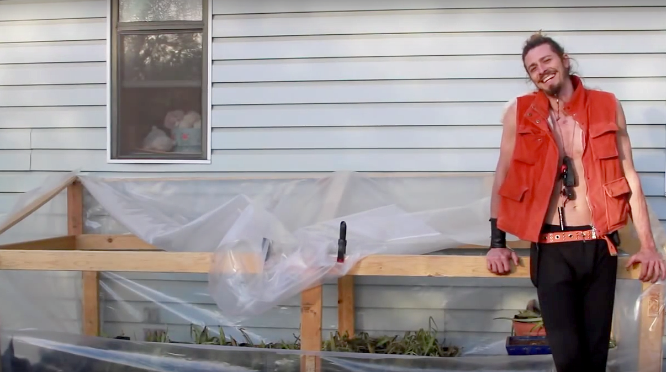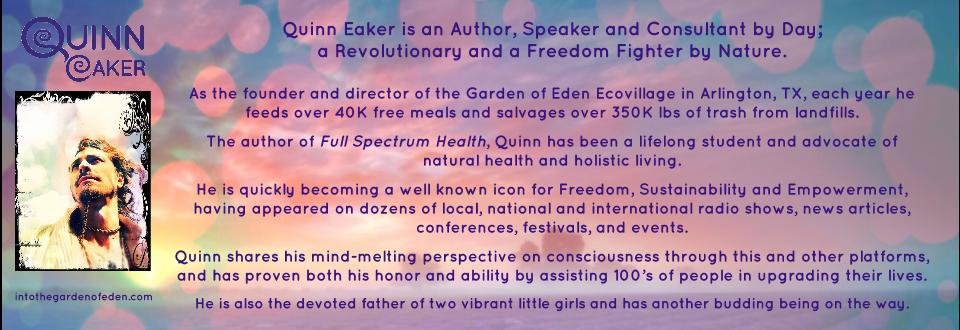Ahh, it is a beautiful day in the Garden of Eden, and its that time of year where the warmth of the summer turns to the cold of the winter and almost all summer crops die. So we've got a couple greenhouse realities going on here. And if you live pretty much anywhere but the tropics, then greenhouses are a very important part of a fully sustainable food production system.

Greenhouse consciousness in the Garden of Eden! This greenhouse, I really love it because it's so easy and it's so simple. All I have is a piece of plastic that is draped over a basic wood frame. If you would like to watch a video on greenhouse consciousness I have included that at the bottom. Otherwise I have summarized it in this article!
We use greenhouses here in the fall, winter, and early spring. We use them in the fall to extend the life of our summer crops. We use them in the winter to actually grow things that we couldn't otherwise grow in the wintertime. And then we use them in the spring to start our seeds a month or two months before the actual planting would take place.
So even if you don't grow in a greenhouse all fall and all winter long, a greenhouse in the spring is really important because you can start your seeds a month or two months early. That way, when you plant your plants, you've got a plant that's already a month/two months big, and you're gonna get production in the first month of planting versus having to wait multiple months.
Sustainability is really important to me and my comprehension/practice of that is unique/extreme so I won't get into that too much here.
Yet the most important part about sustainability is not relying upon a blueprint, not relying upon a system or a formula, but actually comprehending how life works. So rather than me tell you the dimensions of this greenhouse and exactly how to build it and how we built it, what I really want to do is focus on the facets of a greenhouse that make a greenhouse work. (I can put together a future post on a super sustainable and functional greenhouse if there is interest in that.)
Important aspects to consider in building a greenhouse are:
- Light
- Heat
- Watering
- Location
- Materials
LIGHT
So number one, a greenhouse has to allow light to come in. The sun needs to come in. So glass is the best, next would be plexiglass, and then third would be some sort of a clear plastic. You can get high quality greenhouse plastic that allows about a 90 to 95 percent light percentage rate, which is pretty good. Glass can be more like 98 to 99 percent, so glass is not only better then the plastic as far as letting in light, but it also insulates much better and lasts much longer. You can't use plastic that's too thick or too white or too colored, it needs to be a transparent plastic on the thinner side. Of course the thicker it is, the better heat retention there is going to be, but it will let in less light.
So plastic is a good choice for a temporary or cheap green house, glass is going to work better and last a lot longer, though if you have to buy the glass it is going to cost a LOT more.
HEAT
So it's gotta let light in, number two it's got to hold the warmth. So a couple things that need to take place for that is... 1 you need to have some sort of radiant mass, which is basically a mass that absorbs the heat and then radiates that heat into the greenhouse during the night, because when you're using a greenhouse you may have a 70 degree day but then at night it's 30 degrees or even colder, so you need to have some way for the greenhouse to stay warm.
This can be done that with rocks or bricks or some sort of stone; you could have big black trash bags filled with leaves (that's my favorite), even black pots full of soil will absorb some heat and then radiate that back out. Strawberries are a solid choice especially with a black tarp or blanket covering it to absorb more heat.
Another option is that you can cover the greenhouse at night. It's not as convenient because you've got to cover it every single night but you could have a much bigger thicker tarp or blanket or something like that and you could cover the greenhouse so it doesn't get as cold at night
Another option is that you can use some kind of heat generating resource, the best would be compost for example. You could actually put active compost inside of your greenhouse, and the compost is creating a lot of heat, and so that heat is then going to emit into the greenhouse and it's going to keep it warm.
Another key factor to a good greenhouse is for it to be relatively "air tight", because if it's not, then once it gets cold at night that cold air is gonna come in and the hot air is going to escape.
Now of course a greenhouse does have to breathe in order for the plants to survive, but really the best option is to have a greenhouse like this for example: we've got the flaps open right now. It was a nice sunny day, a nice warm day, so we just pulled the flaps aside. We've got some little clips here, and once it becomes dark (which is gonna be pretty soon), we would just simply take this plastic (pulls tarp over frame) and we just clip it on. So what's happening is we're allowing air to get in during the day when it's warmer, and then at night we're covering it with plastic, we're getting it "air tight" so there's less cold air that's gonna come in and less warm air that's going to escape.

So all we've got here is just a basic wood frame. We've got it up against the backside of a house, which is a really good option because that house is actually providing a radiant mass. The house will never be as cold as it will be outside, so the backside of the house will actually keep the inside of the greenhouse from getting too cold. So all we've got really is just a wood frame and then we've just got plastic stapled to the sides, and it's actually removable on the top so we can allow air in there during the day, and then we can clamp it down at night. So it's a very basic wood frame, the dimensions, all the specific of that to me doesn't really matter. What matters is the facets of a greenhouse.
WATER
We pull the plastic back in the day and we just water it with a little sprinkler. It is important to take into account the watering factor. Most greenhouses have to be watered quite a bit, especially if you are doing sprouting, because in order do sprouting you have to have very moist soil. So, you do have to be able to water your greenhouse, and obviously we can't water the greenhouse with the plastic on, but it's very easy to pull it back, do a little sprinkle, and then push it back again. Even when it's cold out.
LOCATION
Another factor that needs to be considered is where you are. We're in Texas where it doesn't get super cold, we don't need a super badass greenhouse. In certain places, it is very cold and you would need a lot more radiant mass or a lot more compost to keep it hot, or other factors.
MATERIALS
My main priority is using free, recycled, abundantly available materials. So all this wood was free, all this plastic was free. So this was perfect and it works exactly for how I want it to.
So there's all types of greenhouses...if you were to go on google and YouTube and you were to start to look at greenhouses, you would find hundreds of different types of greenhouses. It'll give you plans and dimensions, all types of stuff. My main purpose here is to give you the perspective, the consciousness that is the foundation for a proper greenhouse so that you know the questions to ask, what to look for so you can build the ideal greenhouse for your specific application.
This example is sufficient. It's not pretty, it's not sophisticated, but it's totally sustainable, it's super easy, and it works.
Whatever works, whatever works, whatever works!
Bless~*~
Here is the video for anyone interested.


